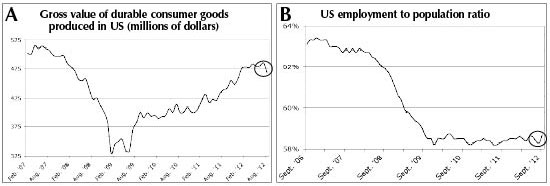

Vol. 76/No. 38 October 22, 2012

|
| Graph A: U.S. manufacturing output declined sharply in 2007-2008. Drop this August comes after more than three and a half years of failing to recover to previous levels. Increase in recent years is due largely to speedup. Graph B: Employment to population ratio is more objective measure than government’s official unemployment rate. Failure of any significant recovery in employment over three-year period is unprecedented in U.S. history and puts questionable September rise—most of which appears to come from increase in part-time jobs—in perspective. |
Global trade, which has grown an average of 6 percent a year over the past two decades, is projected by the World Trade Organization to expand this year by only 2.5 percent, half its volume the year before.
In the Port of Los Angeles, the nation’s largest, outbound containers fell 10.5 percent in August from a year ago. That same month in China’s Shanghai port, the world’s largest by volume, shipping containers passing its quays declined by 6 percent.
“Outright declines in world trade volumes are rare,” notes the Wall Street Journal. “Apart from the severe 12 percent drop in 2009, total world trade declined only three times in the past half century.”
Manufacturing and exports are slowing in China, the world’s second-largest economy. In September, Chinese industrial production contracted for the 11th consecutive month, according to an HSBC report, with new export orders declining to its lowest rate in three-and-a-half years.
This year the Chinese economy is projected to expand by about 7.5 percent, notes the Journal, but this is its “weakest annual expansion since 1990.”
The slowing of the steel industry in China has reduced imports of metallurgical coal, causing the price of coal used for steelmaking to tumble nearly 50 percent.
Coal production is falling in the Appalachian region of the U.S., which includes West Virginia and parts of Kentucky and Virginia. Patriot Coal Corp. has laid off more than 1,200 miners as well as cut health benefits to 2,000 miners and some 20,000 retirees or surviving spouses, reported the Journal.
Alpha Natural Resources Inc. said it was cutting 1,200 jobs. Earlier this year it laid off 700 miners and cut production at more than 20 mines. ConsolEnergy Inc. in early September closed one of its largest mines in southwestern Virginia, which employed 620 miners.
Imports by China from nations in Asia, like Singapore and Thailand, which supply parts for goods produced for exports from China has also been declining.
Manufacturing has been dropping for some time in Greece and Spain, two of the less developed and hardest hit countries among the 17 nations that share the euro.
In Greece, which has been in a recession for the past five years, output from factories, mines and utilities fell 5 percent on the year in July, according to the Hellenic Statistical Authority. With the exception of a miniscule blip in June, industrial output has fallen for the past 50 months.
Factories there have been operating at less than 60 percent of capacity, reports the Journal. One-quarter of the workforce is officially unemployed and more than double that amount for youth under age 25.
In Spain, with similarly high unemployment rates, industrial sales have been steadily declining for the first seven months of 2012, down about 8 percent on the year, according to Bloomberg News.
Even Germany, the top manufacturer and strongest economy in Europe, faces an economic slowdown. Industrial production dropped for the fifth consecutive month in August, with new export orders falling at its steepest rate since April 2009, according to the Markit manufacturing data. German capitalism is heavily driven by exports, two-thirds of which go to countries in the European Union. To compensate for falling demand in Europe, Germany is shifting more exports to China, Russia and the U.S.
Durable goods orders drop in U.S.
In the U.S., orders for durable goods dropped 13.2 percent in August, the most since January 2009. This included aircraft, and automobiles and transportation orders, which fell nearly 35 percent. Overall factory orders that month were down 5.2 percent, the Commerce Department reported.This decline takes place in the context of manufacturing output that has never fully recovered from the recession that officially ended in June 2009. Before this most recent decline, production had risen from 20 percent below pre-recession levels to about 5 percent below, largely through speedup and intensification of labor. See chart A on production of durable goods.
In September, the official U.S. unemployment rate was 7.8 percent, a decline of 0.3 percent from the previous month, reported the Labor Department. While providing good headlines for incumbent President Barack Obama’s reelection bid, the figures indicate no significant change in the long-term stagnation of jobs during the “recovery.”
The employment to population ratio, which measures the percentage of the total population that is employed, rose by 0.4 to 58.7 percent in September. But it has fluctuated between 58.2 and 58.7 percent since September 2009 after falling sharply from 63.4 percent at the end of 2006. The length of this stagnation is unprecedented in U.S. history. See chart B.
In addition, the slight increase is questionable. The government released two varying reports on how much jobs rose in September. According to an employers’ survey, 114,000 jobs were added. But a household survey—which is used for official statistics—puts the figure at 873,000. Two-thirds of these new jobs—582,000—are part time, which the government counts as being employed. There are now 8.6 million workers seeking full-time work forced into part-time status.
So, according to the household survey, the increase in employment can largely be accounted for by the growth of part-time jobs. The numbers the Labor Department reports in September who are either unemployed, forced to work part time, or not counted because they’re labeled as discouraged, adds up to 14.7 percent of the labor force, unchanged from August.
Front page (for this issue) |
Home |
Text-version home